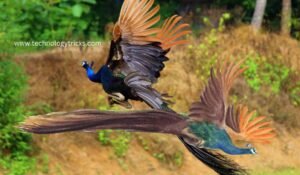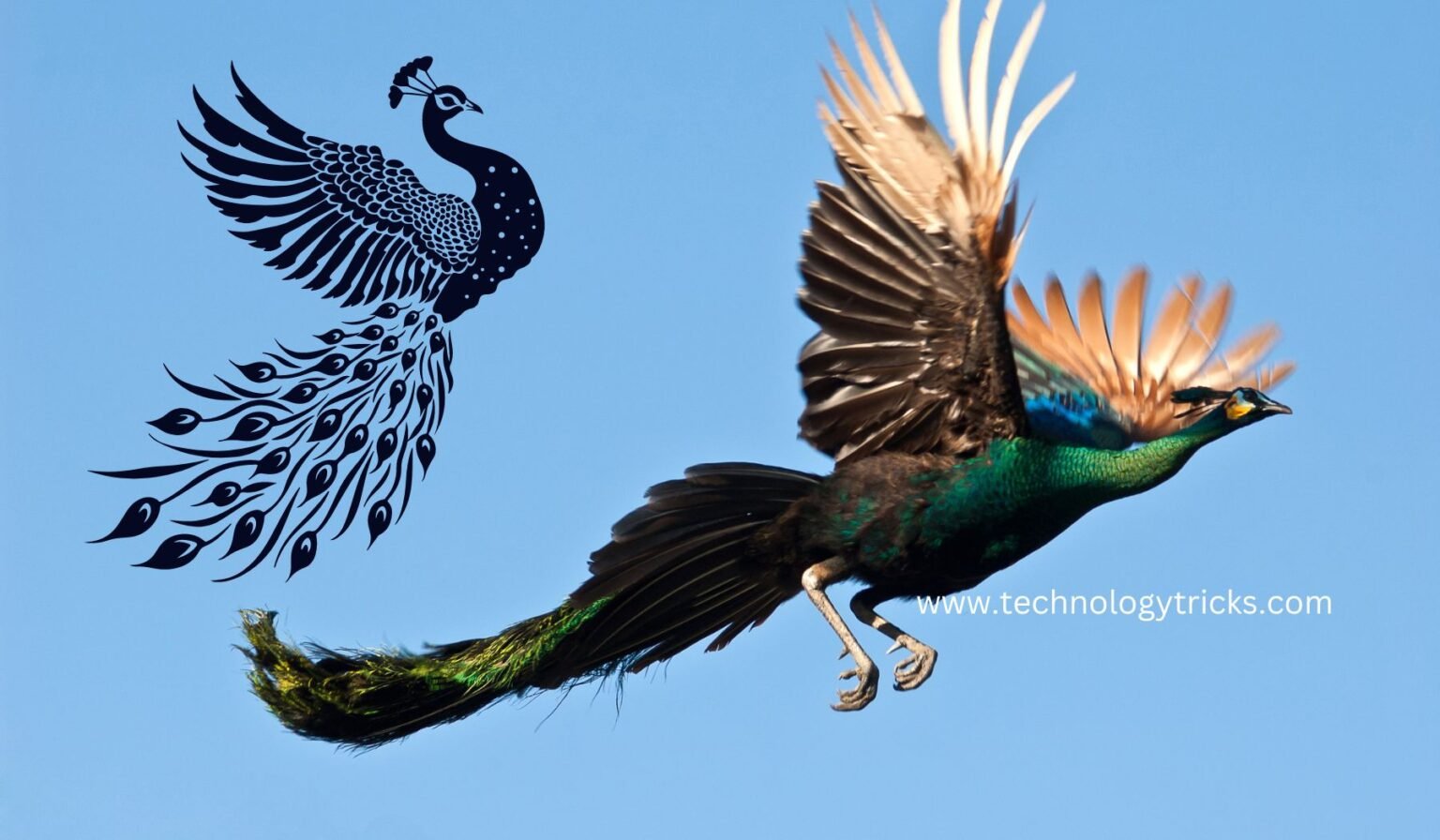Do peacocks fly ? These peacocks are characterized by bright plumage and spectacular feathers on their tail, giving them a ground-dwelling characteristic since many people perceive them to walk on the ground to showcase their glaze. One of the most frequently asked questions remains whether peacocks can fly. While they have relatively big sizes and supposedly unwieldy tails, peacocks do fly, though quite differently from many birds. Biology, behavior, and myths about flight capabilities in peacocks are discussed in this article. We try to come up with the best explanation of the ability of peacocks to take to the skies by going through scientific data and scrutiny of how the birds use their wings.
Can Peacocks Fly? The Answer Explained

Yes, peacocks can fly, but not long-range and not high-altitude flying. Rather, peacocks fly in short, swift flights as part of fleeing from predators or to reach high vantage points for resting, like tree branches, where they often roost. Generally speaking, they fly briefly and cover distances up to a few hundred meters by rapidly going upwards followed by a gentle glide.
Understanding Peacock Flight Mechanics
Peacocks fly very differently compared with many other birds. With their large body size and heavy feathers on their tails, peacocks have adapted a style of flight that is energy-sparing and for limited purposes, such as escaping an enemy or flying up to a safe resting platform.
Wing Structure and Function
The peacock has powerful and broad wings, with a wingspan of about 4.9 to 5.5 feet, or 1.5 to 1.7 meters. These wings are well-suited for flying in spurts, allowing the bird to lift its body off the ground very quickly. Unlike migratory birds, whose narrow wings are meant to sustain long flights, peacocks have broader wings principally for flight in spurts and maneuverability.
Tail Feathers and Their Impact on Flight
Probably the most striking feature about peacocks are their elongated tail feathers-known as trains-which, on some males, can exceed 5 feet. While these feathers are important in displays to females and other peacocks during mating season, they carry a considerable amount of weight and create drag during flight. Because of this, peacocks have to use more energy to produce lift off the ground and sustain flight; thus, peacocks cannot fly very long distances.
Table 1: Peacock Flight Characteristics
| Feature | Description |
|---|---|
| Wingspan | 4.9 to 5.5 feet (1.5 to 1.7 meters) |
| Tail Length (Train) | Up to 5 feet (1.5 meters) |
| Flight Distance | Short, typically a few hundred meters |
| Flight Purpose | Escaping predators, reaching perches, maneuverability |
The Function of Flight in Peacock Behaviour

Flight is very significant in peacocks as it pertains to their survival and daily undertakings. While peafowl are known to spend a great deal of their time on the ground foraging, searching for food, flying is essential in a few key aspects of peacock behaviour: to flee from predators, to roost, and to engage in territorial displays.
Escaping from Predators
They have numerous predators, primarily large carnivores and birds of prey. The effectiveness of peacocks making a speedy takeoff and flying to a better location is essential in their protection from predators. In flight, if threatened, a peacock will take a few running strides and launch into the air, utilizing their powerful wings to rise upward and put distance between itself and the predator.
Roosting in Trees
This is one reason peacocks can be found commonly roosting in trees at nighttime, since most ground predators will not be able to reach them in flight. Actually, peacocks can fly onto high branches to temporarily rest safely. This is a common activity performed by both wild and domesticated peacocks on a daily basis.
Displays of Territoriality
Male peacocks are famous for the incredible courtship displays in which they spread their tail feathers to attract a mate. Though these elaborate displays do occur on the ground, flight can be one such means for establishing dominance and control over a given territory. Males fly onto high perches so as to advertise their presence and to deter competition.
How Far Can Peacocks Fly?
They are capable of flying distances of up to several hundred meters at one flight. The flight distance may be covered, but generally, these flights are short and straight ahead to reach some place rather than covering great ground. While the peacocks take short sprints to move from one place to another, the migratory birds fly several miles at one stretch.
Table 2: Flight Range of Peacocks Compared to Other Birds
| Bird Species | Average Flight Distance | Flight Purpose |
|---|---|---|
| Peacock | A few hundred meters | Short bursts for escape and roosting |
| Pigeon | Up to 600 miles (965 km) | Long-distance travel |
| Sparrow | Up to 2 miles (3.2 km) | Short-distance foraging |
| Albatross | Thousands of miles | Long-distance migration |
Peacock Flight: How It Evolved
One interesting feature about the peacocks has to do with flight. The evolution of peacock flight balanced their survival with reproduction.
Short-Distance Flight Adaptations
Over time they developed numerous adaptations that would allow flying for short lengths of distances: powerful legs and large wings are the power one needs to take off quickly while relatively low body weight is part of what gives them more lift. Even though peacocks had quite a few problems with their tail feathers, they didn’t lose the ability for short flights because this was so crucial for natural survival.
Sexual Selection and Tail Feathers
Sexual selection is the process through which the bright plumage and extremely long tail feathers have evolved in male peacocks, whereby females select to mate with those males carrying the largest and most colourful trains. While such ornaments attract mates, they also bear a cost in reduced flight efficiency. This compromise is one of many examples with regard to how peacocks evolve through natural selection and sexual selection, which often contradict each other.
Also read more: denso 447220-4771
Common Misconceptions About Flying Peacocks
Myths and misconceptions tangle the actual flight capabilities of peacocks. Let us look into some of those common myths.
Myth 1: Peacocks Cannot Fly
Probably the most general myth is that peacocks are completely flightless. Probably, people hold this wrong belief because one usually sees these birds either on the ground or when they are courting and do not take flight. Actually, peacocks can fly without any problem, although flight is mostly over small distances.
Myth 2: Peacocks Only Use Their Wings for Display
While peacocks no doubt do use their wings in courtship displays, the appendages also prove to be quite critical for flight. The wings provide both the lift and thrust necessary for the peacocks to escape from the predators, reach the roosting sites, and generally navigate their environments.
Myth 3: Peacocks Are Too Heavy to Fly
Although they are large birds, peacocks don’t have such heavy weights that may not fly. Their wing structure combined with powerful muscles keeps the lift easily maintained. However, flight in the peacock is adapted for quick bursts rather than traveling long distances, and this probably points to why many people see them walking around rather than flying.
Frequently Asked Questions About Peacock Flight
1. Can peacocks fly long distances?
No, peacocks are not designed to take long-distance flights. They can fly short distances, usually a couple of hundred meters, to escape predators or fly to reach roosting sites.
2. How high can peacocks fly?
Peacocks can fly as high as about 10-15 feet, which would suffice when flying onto tree branches or escaping immediate dangers.
3. Do all the peafowl species fly?
Yes, all species of peafowl can fly the Indian peafowl, the green peafowl, and the Congo peafowl. However, they do differ in flow and length concerning flight, with respect to surroundings and needs.
4. Why do peacocks remain on the ground and not fly?
Flying is a tiresome process for the peacocks, so they do not necessarily fly that much. They only fly where need be, such as upon attack or looking for a place to rest in trees.
Also read more: sta ecnl kevin rao
5. Do peacocks fly at night?
Yes, peacocks fly in the dusk hours to reach their roosting spots in trees where they sleep through the night.
Conclusion
While they have the capability for flight, the flying capability of peacocks is not really adapted for great lengths but for short bursts. With very strong and broad wings, this helps in escaping predators and roosting sites. On the other hand, their long tail feathers act as beautiful but limiting factors toward flying over long distances. Understanding the mechanics and purpose behind peacock flight goes a long way toward best appreciating some of the unique adaptations these magnificent birds have developed over time.
Whether envied for their magnificent plumage or their will to survive, peacocks are truly one of the most interesting birds in the animal kingdom. And one would have thought that flying-though often misinterpreted-simply testifies to their versatility and success in evolution. Combining strength, agility, and strategic flight allows peacocks to thrive in a variety of environments all over the world.

